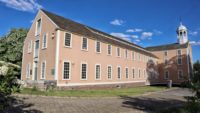Building a company with staying power is no easy feat. Many firms doing well today may eventually find themselves faced with threats to their long-term continuity—by the invasion of radical innovations, an inability to adapt to changes in the external environment or gradual deterioration of the potency of their own core businesses.
In all cases, the effect is the same: They lose the ability to satisfy their transitional markets.

One notable characteristic of ENR's Top Lists is that, like the Fortune 500 and the S&P 500, they experience a lot of turnover. A quintessential example is the automotive industry, where a seismic shift in how vehicles are powered, driven and purchased has traditional carmakers struggling to reinvent themselves or risk being commoditized.
It is no accident that Tesla, a 17-year-old startup, is now worth a General Motors plus a Daimler plus a Ford plus a Toyota plus all the ENR top design firms. Even many of Jim Collins’ “great” companies have failed the test of time and fallen, struggled financially, required government bailout, faced fraud, were absorbed into more successful enterprises or forced to fold.
Engineering and construction firms cannot continue with business as usual, doing more of what they know best, looking at traditional competitors as the greatest threat and viewing their rankings on ENR lists as a measure of performance. They may see the current operating model as producing more predictable financial results more quickly to keep shareholder benefits coming. But that model focuses firms inward rather than outward, where the real problems lie, and makes them more resistant to the need for strategic change.
The leaders of engineering and construction firms must pursue two important strategies at once. Business longevity hinges, in part, on how well they cooperate with the dynamic marketplace, strategically managing business cycle turbulence. They must live in a state of positive dissatisfaction, forever striking a balance between managing for today’s requirements, such as efficiency (doing things right) and tomorrow’s possibilities and effectiveness (doing the right things).
Too much of the former—for example sizing to market, managing risks and increasing utilization, billable hours and labor multipliers—may reinforce the status quo, and that hinders long-term adaptability. Too much of the latter may fail to capture the value of early innovations and potentially damage the core operations that provide essential cash flow and the capability to invest in growth. Playing both games concurrently gives firms their best chance of staying vibrant and sustainable.
Enduring firms are resilient and sustain their adaptiveness across all time scales and business climates.
They manage the present core business at peak efficiency and profitability while securing long-term viability. They create a dual capacity to exploit their current business while exploring new opportunities. They are quick to read and act on signals of change, transforming themselves multiple times to weather the turbulence. They work backward from the future, and then they inject innovation into their business models and adapt to the new realities. They do not fight (or ignore) a changing trend, but get ahead of it, because they know defenders of the status quo eventually lose. They innovate.
Many firms are recognizing the need to capitalize on opportunities presented by the external environment while maintaining the excellence of their existing core operations. Some, such as Parsons and Jacobs, have acquired technology companies, while others have chosen to monetize IP or launch new ventures. By managing with efficiency and effectiveness, engineering and construction firms can not only stay ahead of change, but also create it. They can grow and profit from new businesses, piling new successes on existing ones—and sustaining them.
Ambidextrous engineering and construction leaders strike a delicate balance between operations and innovation, and shape the rules of tomorrow’s game before competitors do—creating organizations that are not only built to last but also built to lead.
Paul F. Boulos, Ph.D., NAE, is a former president of MWH Global and founder and CEO of Innovyze and Digital Water Works. He can be reached at pfboulos@yahoo.com.
If you have an idea for a column, please contact Viewpoint Editor Richard Korman at kormanr@enr.com.





Post a comment to this article
Report Abusive Comment